check engine CHEVROLET COBALT 2007 1.G Owner's Manual
[x] Cancel search | Manufacturer: CHEVROLET, Model Year: 2007, Model line: COBALT, Model: CHEVROLET COBALT 2007 1.GPages: 450, PDF Size: 2.48 MB
Page 282 of 450
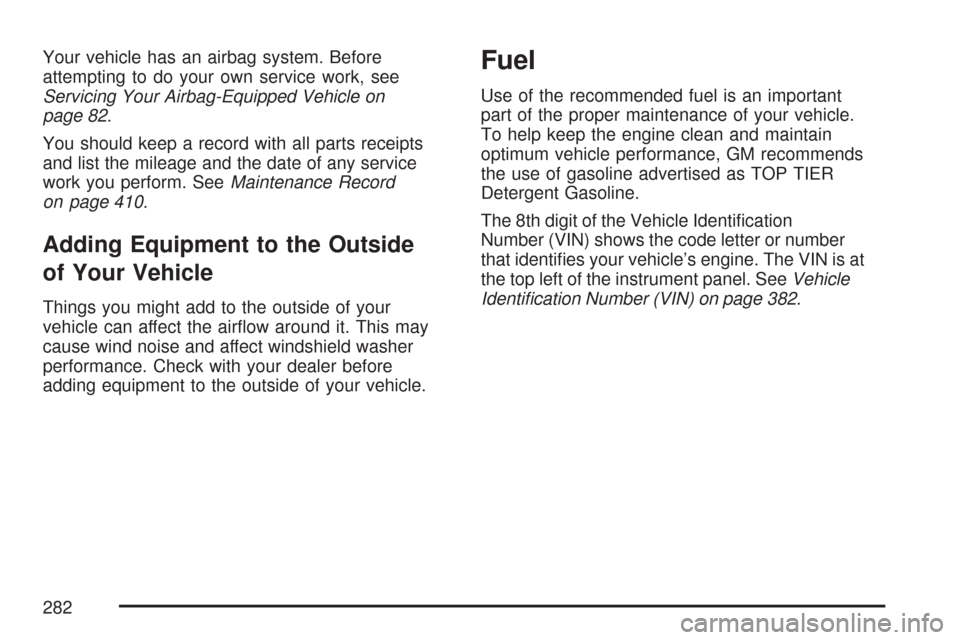
Your vehicle has an airbag system. Before
attempting to do your own service work, see
Servicing Your Airbag-Equipped Vehicle on
page 82.
You should keep a record with all parts receipts
and list the mileage and the date of any service
work you perform. SeeMaintenance Record
on page 410.
Adding Equipment to the Outside
of Your Vehicle
Things you might add to the outside of your
vehicle can affect the air�ow around it. This may
cause wind noise and affect windshield washer
performance. Check with your dealer before
adding equipment to the outside of your vehicle.
Fuel
Use of the recommended fuel is an important
part of the proper maintenance of your vehicle.
To help keep the engine clean and maintain
optimum vehicle performance, GM recommends
the use of gasoline advertised as TOP TIER
Detergent Gasoline.
The 8th digit of the Vehicle Identi�cation
Number (VIN) shows the code letter or number
that identi�es your vehicle’s engine. The VIN is at
the top left of the instrument panel. SeeVehicle
Identi�cation Number (VIN) on page 382.
282
Page 283 of 450
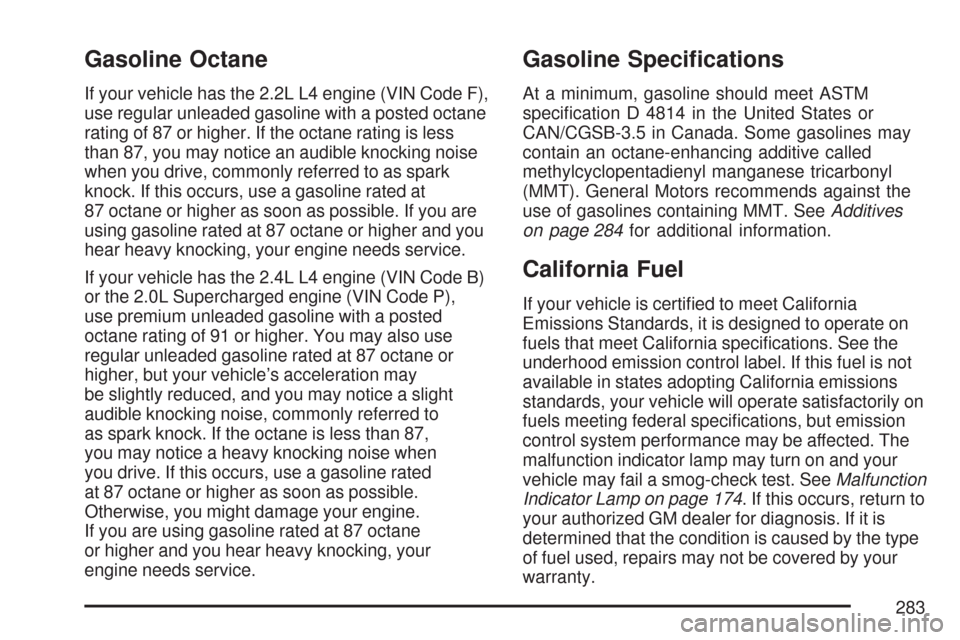
Gasoline Octane
If your vehicle has the 2.2L L4 engine (VIN Code F),
use regular unleaded gasoline with a posted octane
rating of 87 or higher. If the octane rating is less
than 87, you may notice an audible knocking noise
when you drive, commonly referred to as spark
knock. If this occurs, use a gasoline rated at
87 octane or higher as soon as possible. If you are
using gasoline rated at 87 octane or higher and you
hear heavy knocking, your engine needs service.
If your vehicle has the 2.4L L4 engine (VIN Code B)
or the 2.0L Supercharged engine (VIN Code P),
use premium unleaded gasoline with a posted
octane rating of 91 or higher. You may also use
regular unleaded gasoline rated at 87 octane or
higher, but your vehicle’s acceleration may
be slightly reduced, and you may notice a slight
audible knocking noise, commonly referred to
as spark knock. If the octane is less than 87,
you may notice a heavy knocking noise when
you drive. If this occurs, use a gasoline rated
at 87 octane or higher as soon as possible.
Otherwise, you might damage your engine.
If you are using gasoline rated at 87 octane
or higher and you hear heavy knocking, your
engine needs service.
Gasoline Speci�cations
At a minimum, gasoline should meet ASTM
speci�cation D 4814 in the United States or
CAN/CGSB-3.5 in Canada. Some gasolines may
contain an octane-enhancing additive called
methylcyclopentadienyl manganese tricarbonyl
(MMT). General Motors recommends against the
use of gasolines containing MMT. SeeAdditives
on page 284for additional information.
California Fuel
If your vehicle is certi�ed to meet California
Emissions Standards, it is designed to operate on
fuels that meet California speci�cations. See the
underhood emission control label. If this fuel is not
available in states adopting California emissions
standards, your vehicle will operate satisfactorily on
fuels meeting federal speci�cations, but emission
control system performance may be affected. The
malfunction indicator lamp may turn on and your
vehicle may fail a smog-check test. SeeMalfunction
Indicator Lamp on page 174. If this occurs, return to
your authorized GM dealer for diagnosis. If it is
determined that the condition is caused by the type
of fuel used, repairs may not be covered by your
warranty.
283
Page 284 of 450
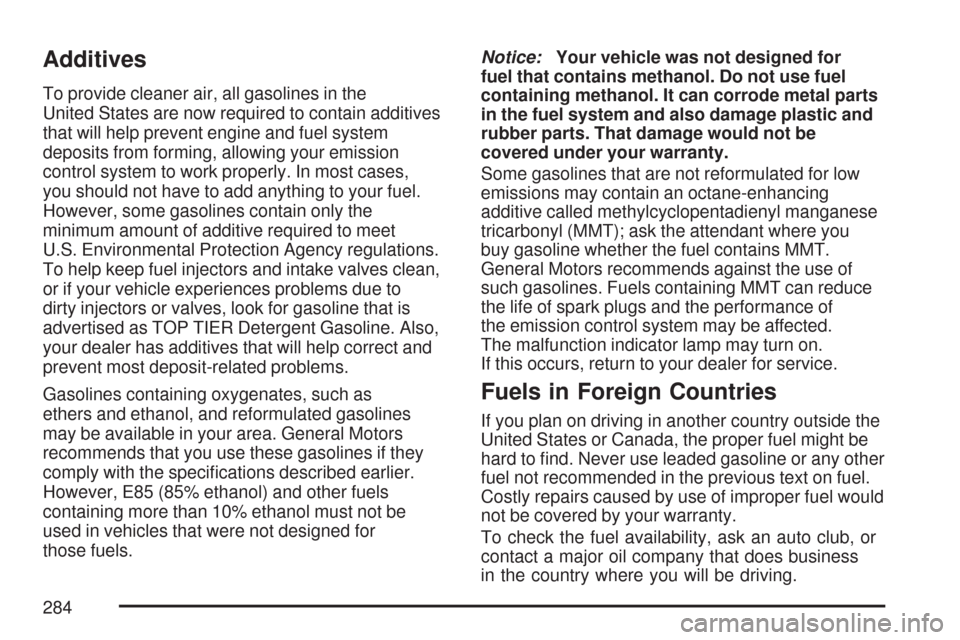
Additives
To provide cleaner air, all gasolines in the
United States are now required to contain additives
that will help prevent engine and fuel system
deposits from forming, allowing your emission
control system to work properly. In most cases,
you should not have to add anything to your fuel.
However, some gasolines contain only the
minimum amount of additive required to meet
U.S. Environmental Protection Agency regulations.
To help keep fuel injectors and intake valves clean,
or if your vehicle experiences problems due to
dirty injectors or valves, look for gasoline that is
advertised as TOP TIER Detergent Gasoline. Also,
your dealer has additives that will help correct and
prevent most deposit-related problems.
Gasolines containing oxygenates, such as
ethers and ethanol, and reformulated gasolines
may be available in your area. General Motors
recommends that you use these gasolines if they
comply with the speci�cations described earlier.
However, E85 (85% ethanol) and other fuels
containing more than 10% ethanol must not be
used in vehicles that were not designed for
those fuels.Notice:Your vehicle was not designed for
fuel that contains methanol. Do not use fuel
containing methanol. It can corrode metal parts
in the fuel system and also damage plastic and
rubber parts. That damage would not be
covered under your warranty.
Some gasolines that are not reformulated for low
emissions may contain an octane-enhancing
additive called methylcyclopentadienyl manganese
tricarbonyl (MMT); ask the attendant where you
buy gasoline whether the fuel contains MMT.
General Motors recommends against the use of
such gasolines. Fuels containing MMT can reduce
the life of spark plugs and the performance of
the emission control system may be affected.
The malfunction indicator lamp may turn on.
If this occurs, return to your dealer for service.
Fuels in Foreign Countries
If you plan on driving in another country outside the
United States or Canada, the proper fuel might be
hard to �nd. Never use leaded gasoline or any other
fuel not recommended in the previous text on fuel.
Costly repairs caused by use of improper fuel would
not be covered by your warranty.
To check the fuel availability, ask an auto club, or
contact a major oil company that does business
in the country where you will be driving.
284
Page 288 of 450
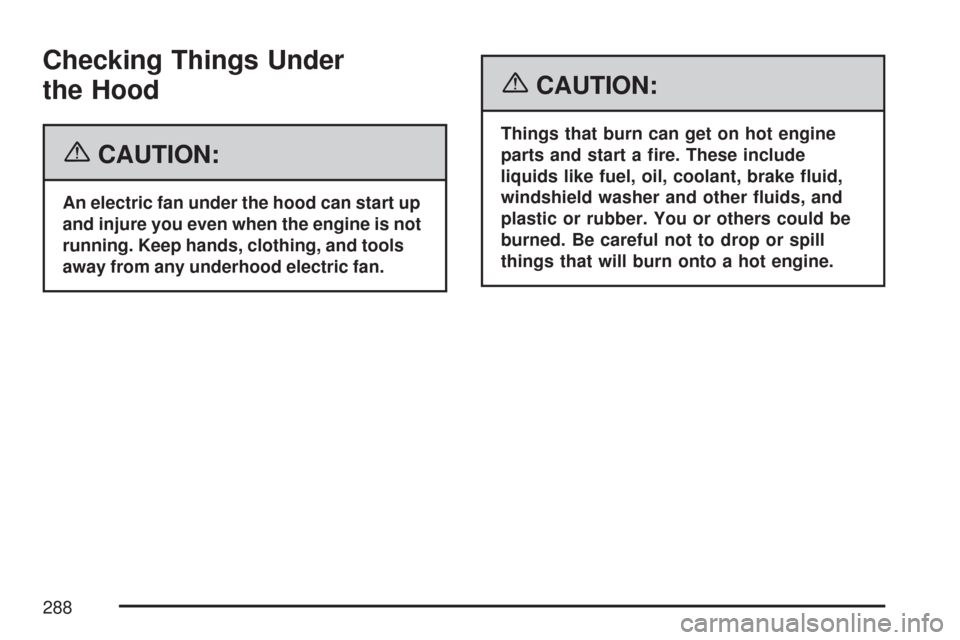
Checking Things Under
the Hood
{CAUTION:
An electric fan under the hood can start up
and injure you even when the engine is not
running. Keep hands, clothing, and tools
away from any underhood electric fan.
{CAUTION:
Things that burn can get on hot engine
parts and start a �re. These include
liquids like fuel, oil, coolant, brake �uid,
windshield washer and other �uids, and
plastic or rubber. You or others could be
burned. Be careful not to drop or spill
things that will burn onto a hot engine.
288
Page 291 of 450
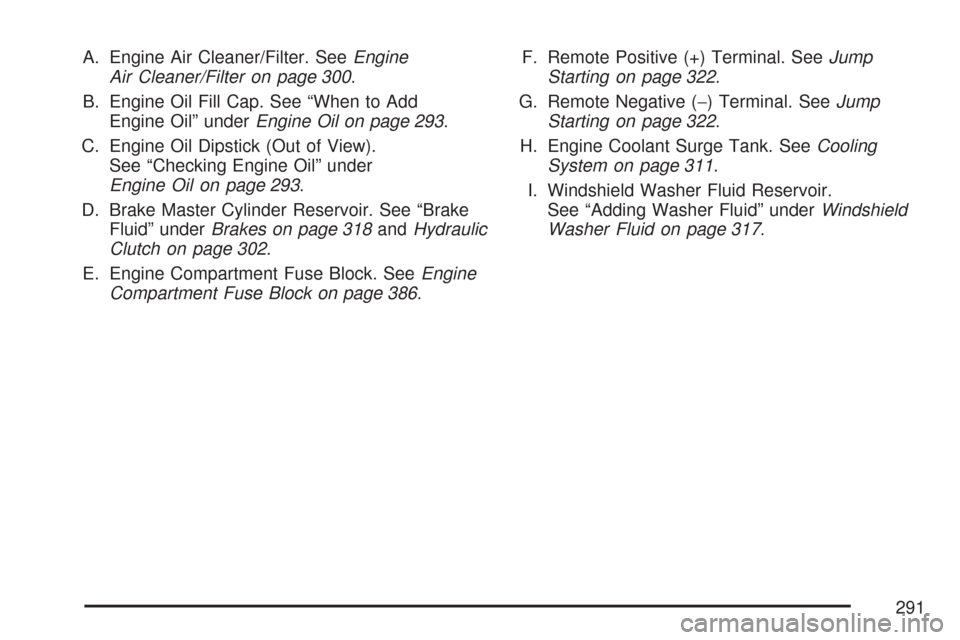
A. Engine Air Cleaner/Filter. SeeEngine
Air Cleaner/Filter on page 300.
B. Engine Oil Fill Cap. See “When to Add
Engine Oil” underEngine Oil on page 293.
C. Engine Oil Dipstick (Out of View).
See “Checking Engine Oil” under
Engine Oil on page 293.
D. Brake Master Cylinder Reservoir. See “Brake
Fluid” underBrakes on page 318andHydraulic
Clutch on page 302.
E. Engine Compartment Fuse Block. SeeEngine
Compartment Fuse Block on page 386.F. Remote Positive (+) Terminal. SeeJump
Starting on page 322.
G. Remote Negative (−) Terminal. SeeJump
Starting on page 322.
H. Engine Coolant Surge Tank. SeeCooling
System on page 311.
I. Windshield Washer Fluid Reservoir.
See “Adding Washer Fluid” underWindshield
Washer Fluid on page 317.
291
Page 293 of 450
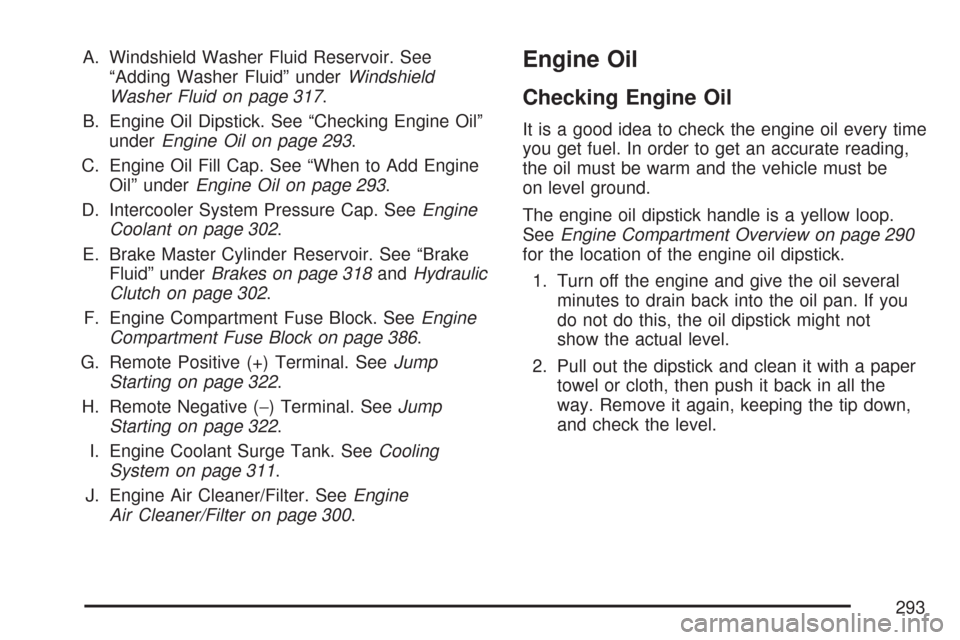
A. Windshield Washer Fluid Reservoir. See
“Adding Washer Fluid” underWindshield
Washer Fluid on page 317.
B. Engine Oil Dipstick. See “Checking Engine Oil”
underEngine Oil on page 293.
C. Engine Oil Fill Cap. See “When to Add Engine
Oil” underEngine Oil on page 293.
D. Intercooler System Pressure Cap. SeeEngine
Coolant on page 302.
E. Brake Master Cylinder Reservoir. See “Brake
Fluid” underBrakes on page 318andHydraulic
Clutch on page 302.
F. Engine Compartment Fuse Block. SeeEngine
Compartment Fuse Block on page 386.
G. Remote Positive (+) Terminal. SeeJump
Starting on page 322.
H. Remote Negative (−) Terminal. SeeJump
Starting on page 322.
I. Engine Coolant Surge Tank. SeeCooling
System on page 311.
J. Engine Air Cleaner/Filter. SeeEngine
Air Cleaner/Filter on page 300.Engine Oil
Checking Engine Oil
It is a good idea to check the engine oil every time
you get fuel. In order to get an accurate reading,
the oil must be warm and the vehicle must be
on level ground.
The engine oil dipstick handle is a yellow loop.
SeeEngine Compartment Overview on page 290
for the location of the engine oil dipstick.
1. Turn off the engine and give the oil several
minutes to drain back into the oil pan. If you
do not do this, the oil dipstick might not
show the actual level.
2. Pull out the dipstick and clean it with a paper
towel or cloth, then push it back in all the
way. Remove it again, keeping the tip down,
and check the level.
293
Page 298 of 450
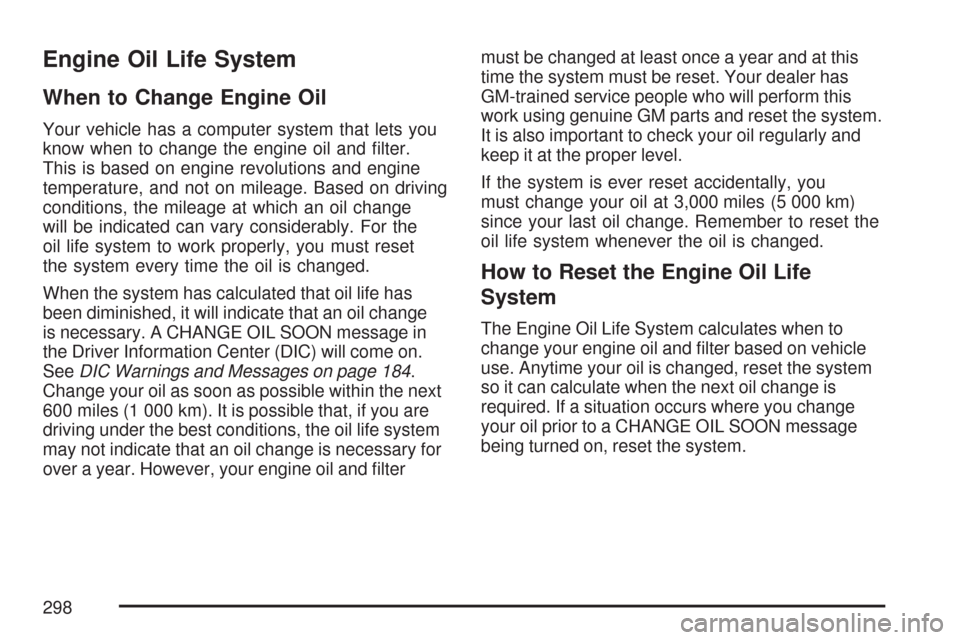
Engine Oil Life System
When to Change Engine Oil
Your vehicle has a computer system that lets you
know when to change the engine oil and �lter.
This is based on engine revolutions and engine
temperature, and not on mileage. Based on driving
conditions, the mileage at which an oil change
will be indicated can vary considerably. For the
oil life system to work properly, you must reset
the system every time the oil is changed.
When the system has calculated that oil life has
been diminished, it will indicate that an oil change
is necessary. A CHANGE OIL SOON message in
the Driver Information Center (DIC) will come on.
SeeDIC Warnings and Messages on page 184.
Change your oil as soon as possible within the next
600 miles (1 000 km). It is possible that, if you are
driving under the best conditions, the oil life system
may not indicate that an oil change is necessary for
over a year. However, your engine oil and �ltermust be changed at least once a year and at this
time the system must be reset. Your dealer has
GM-trained service people who will perform this
work using genuine GM parts and reset the system.
It is also important to check your oil regularly and
keep it at the proper level.
If the system is ever reset accidentally, you
must change your oil at 3,000 miles (5 000 km)
since your last oil change. Remember to reset the
oil life system whenever the oil is changed.
How to Reset the Engine Oil Life
System
The Engine Oil Life System calculates when to
change your engine oil and �lter based on vehicle
use. Anytime your oil is changed, reset the system
so it can calculate when the next oil change is
required. If a situation occurs where you change
your oil prior to a CHANGE OIL SOON message
being turned on, reset the system.
298
Page 301 of 450
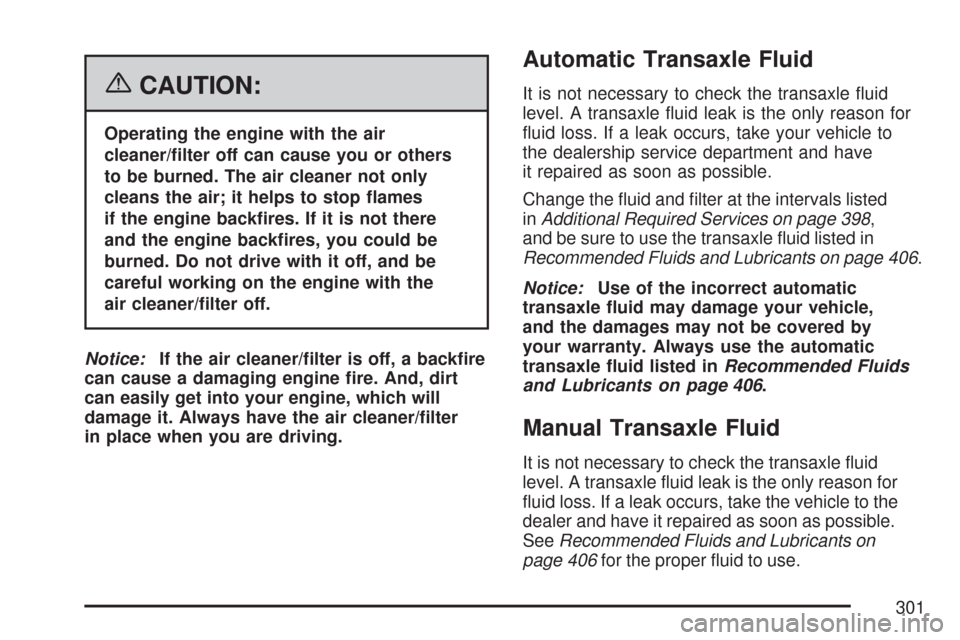
{CAUTION:
Operating the engine with the air
cleaner/�lter off can cause you or others
to be burned. The air cleaner not only
cleans the air; it helps to stop �ames
if the engine back�res. If it is not there
and the engine back�res, you could be
burned. Do not drive with it off, and be
careful working on the engine with the
air cleaner/�lter off.
Notice:If the air cleaner/�lter is off, a back�re
can cause a damaging engine �re. And, dirt
can easily get into your engine, which will
damage it. Always have the air cleaner/�lter
in place when you are driving.
Automatic Transaxle Fluid
It is not necessary to check the transaxle �uid
level. A transaxle �uid leak is the only reason for
�uid loss. If a leak occurs, take your vehicle to
the dealership service department and have
it repaired as soon as possible.
Change the �uid and �lter at the intervals listed
inAdditional Required Services on page 398,
and be sure to use the transaxle �uid listed in
Recommended Fluids and Lubricants on page 406.
Notice:Use of the incorrect automatic
transaxle �uid may damage your vehicle,
and the damages may not be covered by
your warranty. Always use the automatic
transaxle �uid listed inRecommended Fluids
and Lubricants on page 406.
Manual Transaxle Fluid
It is not necessary to check the transaxle �uid
level. A transaxle �uid leak is the only reason for
�uid loss. If a leak occurs, take the vehicle to the
dealer and have it repaired as soon as possible.
SeeRecommended Fluids and Lubricants on
page 406for the proper �uid to use.
301
Page 303 of 450
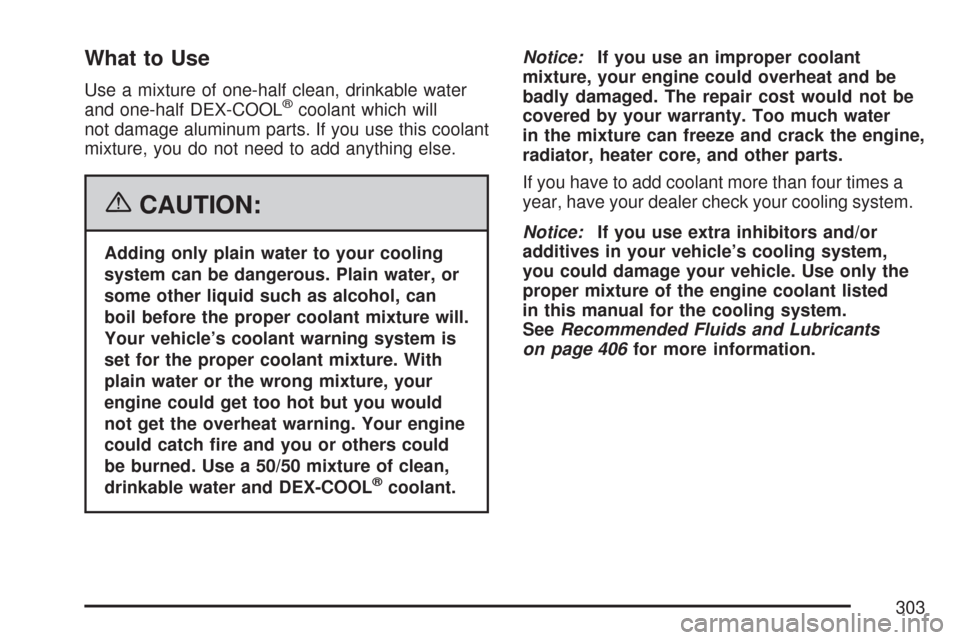
What to Use
Use a mixture of one-half clean, drinkable water
and one-half DEX-COOL®coolant which will
not damage aluminum parts. If you use this coolant
mixture, you do not need to add anything else.
{CAUTION:
Adding only plain water to your cooling
system can be dangerous. Plain water, or
some other liquid such as alcohol, can
boil before the proper coolant mixture will.
Your vehicle’s coolant warning system is
set for the proper coolant mixture. With
plain water or the wrong mixture, your
engine could get too hot but you would
not get the overheat warning. Your engine
could catch �re and you or others could
be burned. Use a 50/50 mixture of clean,
drinkable water and DEX-COOL
®coolant.Notice:If you use an improper coolant
mixture, your engine could overheat and be
badly damaged. The repair cost would not be
covered by your warranty. Too much water
in the mixture can freeze and crack the engine,
radiator, heater core, and other parts.
If you have to add coolant more than four times a
year, have your dealer check your cooling system.
Notice:If you use extra inhibitors and/or
additives in your vehicle’s cooling system,
you could damage your vehicle. Use only the
proper mixture of the engine coolant listed
in this manual for the cooling system.
SeeRecommended Fluids and Lubricants
on page 406for more information.
303
Page 304 of 450

Checking Coolant
The coolant surge tank is located in the engine
compartment on the driver’s side of the vehicle.
SeeEngine Compartment Overview on page 290
for more information on location.
{CAUTION:
Turning the surge tank pressure cap when
the engine and radiator are hot can allow
steam and scalding liquids to blow out
and burn you badly. Never turn the surge
tank pressure cap — even a little — when
the engine and radiator are hot.
The vehicle must be on a level surface. When
your engine is cold, the coolant level should be at
the COLD FILL line.
304